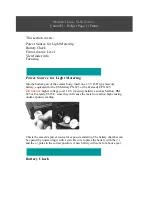
III. IMAGE QUALITY SETTINGS
24
RAW vs. JPEG
JPEG Quality
EOS-1 class digital SLRs allow photographers to shoot RAW files, in-camera JPEGs, or
RAW plus JPEG simultaneously. The RAW file setting records image data directly from the
image sensor at maximum resolution without JPEG compression artifacts, thus resulting
in maximum image quality at the expense of relatively large file sizes on the memory
card. In-camera JPEGs are smaller on the memory card and they can be captured at
either full resolution or various lower resolution settings.
There are several other important differences between RAW files and in-camera JPEGs.
Images originally shot as JPEGs are essentially “processed” in the camera as 24-bit color
files according to the various camera settings for ISO speed, exposure, white balance,
color space, tone curve, sharpness, contrast, saturation and color tone. With the
exception of ISO speed, virtually all of the other settings listed above, including bit
depth, can be adjusted during post-processing with RAW files. RAW files, therefore, offer
far greater flexibility and produce image quality equal or superior to JPEGs in any
reasonable comparison.
For most photographers, the choice between shooting RAW or JPEG lies in the trade-off
between image quality and convenience. In-camera JPEGs are often completely
sufficient in image quality for a tremendous variety of imaging applications. When the
desired camera settings are made ahead of time, JPEGs can really speed up your
workflow. However, RAW files preserve the highest possible image quality, and they
offer a far greater degree of flexibility in terms of image manipulation.
For those who can’t decide between RAW and JPEG, or who may need both for their
workflow, Canon EOS-1 class Digital SLRs also feature a RAW+JPEG simultaneous
capture capability that gives you the best of both worlds, JPEGs for immediate use and a
RAW file for archiving and further manipulation.
JPEG quality, which is Canon’s way of referring to compression settings, can be adjusted
from 1 (maximum compression, minimum image quality) to 10 (minimum compression,
maximum image quality) in 1-step increments. The default JPEG quality setting for EOS-1
class digital SLRs is Level 8. In the case of the original EOS-1D and EOS-1Ds, JPEG
quality adjustment is programmed in your computer and uploaded to the camera via
dedicated software and the IEEE 1394 interface. With the Mark II cameras, JPEG quality
can be adjusted at each of the 4 different resolution settings on the built-in LCD
monitor.
III. IMAGE QUALITY SETTINGS












































